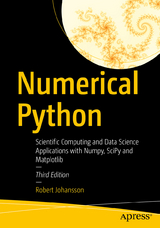
Numerical Python
Scientific Computing and Data Science Applications with Numpy, SciPy and Matplotlib
Seiten
2018
|
Second Edition
Apress (Verlag)
978-1-4842-4245-2 (ISBN)
Apress (Verlag)
978-1-4842-4245-2 (ISBN)
- Lieferbar
- Versandkostenfrei
- Auch auf Rechnung
- Artikel merken
Zu diesem Artikel existiert eine Nachauflage
Leverage the numerical and mathematical modules in Python and its standard library as well as popular open source numerical Python packages like NumPy, SciPy, FiPy, matplotlib and more. This fully revised edition, updated with the latest details of each package and changes to Jupyter projects, demonstrates how to numerically compute solutions and mathematically model applications in big data, cloud computing, financial engineering, business management and more.
Numerical Python, Second Edition, presents many brand-new case study examples of applications in data science and statistics using Python, along with extensions to many previous examples. Each of these demonstrates the power of Python for rapid development and exploratory computing due to its simple and high-level syntax and multiple options for data analysis.
After reading this book, readers will be familiar with many computing techniques including array-based and symbolic computing, visualization and numerical file I/O, equation solving, optimization, interpolation and integration, and domain-specific computational problems, such as differential equation solving, data analysis, statistical modeling and machine learning.
What You'll Learn
Work with vectors and matrices using NumPy
Plot and visualize data with Matplotlib
Perform data analysis tasks with Pandas and SciPy
Review statistical modeling and machine learning with statsmodels and scikit-learn
Optimize Python code using Numba and Cython
Who This Book Is For
Developers who want to understand how to use Python and its related ecosystem for numerical computing.
Numerical Python, Second Edition, presents many brand-new case study examples of applications in data science and statistics using Python, along with extensions to many previous examples. Each of these demonstrates the power of Python for rapid development and exploratory computing due to its simple and high-level syntax and multiple options for data analysis.
After reading this book, readers will be familiar with many computing techniques including array-based and symbolic computing, visualization and numerical file I/O, equation solving, optimization, interpolation and integration, and domain-specific computational problems, such as differential equation solving, data analysis, statistical modeling and machine learning.
What You'll Learn
Work with vectors and matrices using NumPy
Plot and visualize data with Matplotlib
Perform data analysis tasks with Pandas and SciPy
Review statistical modeling and machine learning with statsmodels and scikit-learn
Optimize Python code using Numba and Cython
Who This Book Is For
Developers who want to understand how to use Python and its related ecosystem for numerical computing.
Robert Johansson is a numerical Python expert and computational scientist who has worked with SciPy, NumPy and QuTiP, an open-source Python framework for simulating the dynamics of quantum systems.
1. Introduction to Computing with Python.- 2. Vectors, Matrices and Multidimensional Arrays.- 3. Symbolic Computing.- 4. Plotting and Visualization.- 5. Equation Solving.- 6. Optimization.- 7. Interpolation.- 8. Integration.- 9. Ordinary Differential Equations.- 10. Sparse Matrices and Graphs.- 11. Partial Differential Equations.- 12. Data Processing and Analysis.- 13. Statistics.- 14. Statistical Modeling.- 15. Machine Learning.- 16. Bayesian Statistics.- 17. Signal and Image Processing.- 18. Data Input and Output.- 19. Code Optimization.
| Erscheinungsdatum | 10.01.2019 |
|---|---|
| Zusatzinfo | 63 Illustrations, color; 105 Illustrations, black and white; XXIII, 700 p. 168 illus., 63 illus. in color. |
| Verlagsort | Berkley |
| Sprache | englisch |
| Maße | 178 x 254 mm |
| Themenwelt | Mathematik / Informatik ► Informatik ► Datenbanken |
| Informatik ► Programmiersprachen / -werkzeuge ► Python | |
| Mathematik / Informatik ► Informatik ► Web / Internet | |
| Mathematik / Informatik ► Mathematik ► Computerprogramme / Computeralgebra | |
| Schlagworte | algorithms • Computation • FEniCS • Image Processing • IPython • Jupyter • machine learning • matplotlib • Numerical • NumPy • Python • SciPy • Signal Processing • tensorflow |
| ISBN-10 | 1-4842-4245-9 / 1484242459 |
| ISBN-13 | 978-1-4842-4245-2 / 9781484242452 |
| Zustand | Neuware |
| Informationen gemäß Produktsicherheitsverordnung (GPSR) | |
| Haben Sie eine Frage zum Produkt? |
Mehr entdecken
aus dem Bereich
aus dem Bereich
Schulbuch Klassen 7/8 (G9)
Buch | Hardcover (2015)
Klett (Verlag)
CHF 29,90
Buch | Softcover (2004)
Cornelsen Verlag
CHF 23,90



